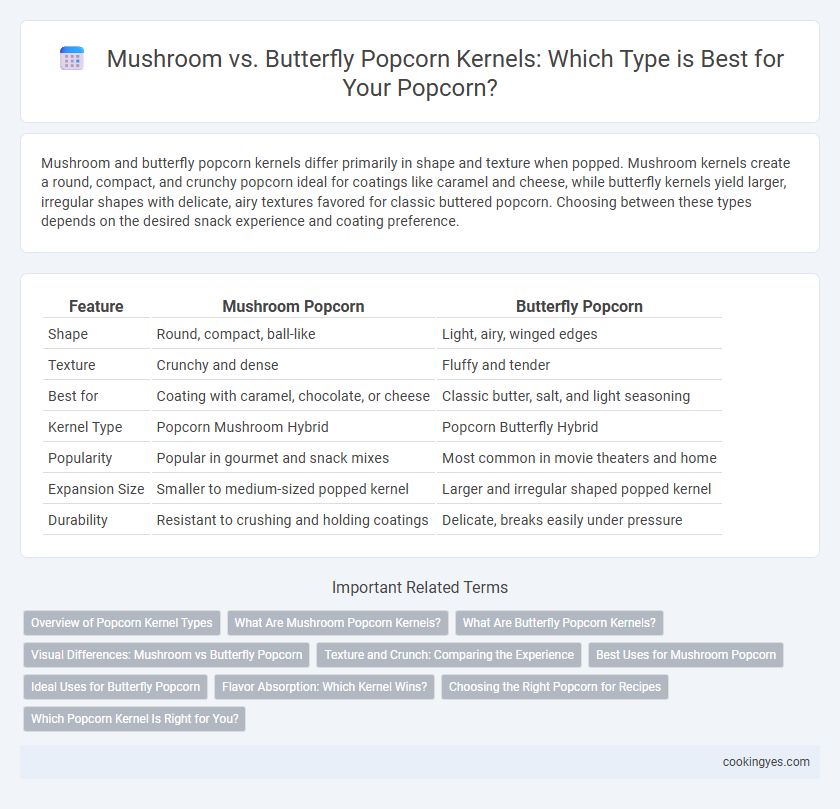Mushroom and butterfly popcorn kernels differ primarily in shape and texture when popped. Mushroom kernels create a round, compact, and crunchy popcorn ideal for coatings like caramel and cheese, while butterfly kernels yield larger, irregular shapes with delicate, airy textures favored for classic buttered popcorn. Choosing between these types depends on the desired snack experience and coating preference.
Table of Comparison
| Feature | Mushroom Popcorn | Butterfly Popcorn |
|---|---|---|
| Shape | Round, compact, ball-like | Light, airy, winged edges |
| Texture | Crunchy and dense | Fluffy and tender |
| Best for | Coating with caramel, chocolate, or cheese | Classic butter, salt, and light seasoning |
| Kernel Type | Popcorn Mushroom Hybrid | Popcorn Butterfly Hybrid |
| Popularity | Popular in gourmet and snack mixes | Most common in movie theaters and home |
| Expansion Size | Smaller to medium-sized popped kernel | Larger and irregular shaped popped kernel |
| Durability | Resistant to crushing and holding coatings | Delicate, breaks easily under pressure |
Overview of Popcorn Kernel Types
Popcorn kernels primarily fall into two types: mushroom and butterfly. Mushroom kernels expand into a round, ball-like shape that is dense and perfect for coatings and caramel because it resists breaking easily. Butterfly kernels pop with irregular wings that create a light, fluffy texture ideal for traditional buttered popcorn and seasoning adherence.
What Are Mushroom Popcorn Kernels?
Mushroom popcorn kernels produce a round, compact shape known for its dense texture and resistance to breaking, making it ideal for coating with caramel or cheese. Unlike butterfly kernels, which expand irregularly with large wings, mushroom kernels puff up into a ball-like form that holds toppings better and offers a crunchier bite. This kernel type is favored in commercial popcorn products where durability and uniformity are essential.
What Are Butterfly Popcorn Kernels?
Butterfly popcorn kernels, also known as snowflake popcorn, feature irregular shapes with several protruding wings, creating a light, airy texture ideal for holding seasoning. These kernels pop larger and fluffier compared to mushroom varieties, making them popular in movie theaters and for snack mixes. Their fragile, delicate structure contrasts with mushroom kernels, which are rounder and more compact, offering durability suitable for caramel or cheese coatings.
Visual Differences: Mushroom vs Butterfly Popcorn
Mushroom popcorn kernels expand into round, compact shapes with a dense, ball-like appearance, ideal for heavy coatings like caramel or cheese. Butterfly popcorn features irregular, winged shapes with open, jagged edges that create a larger surface area and a light, airy texture. The visual contrast lies in mushroom's uniform, mound-like form versus butterfly's sprawling, winged silhouette.
Texture and Crunch: Comparing the Experience
Mushroom popcorn kernels create a dense, round shape that delivers a chewy, compact texture ideal for coatings like caramel or cheese, enhancing crunchiness without breaking apart easily. Butterfly popcorn kernels feature irregular, wing-like shapes that provide a light, airy texture with a crisp, delicate crunch, perfect for traditional buttered popcorn. Texture and crunch differ significantly, with mushroom popcorn favored for durability and coated snacks, while butterfly popcorn excels in a classic crispy eating experience.
Best Uses for Mushroom Popcorn
Mushroom popcorn kernels produce round, compact popped corn ideal for heavy coatings like caramel and cheese because their shape prevents breakage and maintains structural integrity. This type contrasts with butterfly kernels, which have irregular shapes and delicate wings suited for light coatings and conventional snacking. Mushroom popcorn is preferred in commercial production and gourmet recipes where durability and uniformity are crucial for maximizing flavor and texture.
Ideal Uses for Butterfly Popcorn
Butterfly popcorn kernels, known for their irregular, winged shape with multiple protruding "wings," create a light, fluffy texture ideal for movie theaters and snack mixes that require easy seasoning adherence. These kernels expand to a larger size compared to mushroom popcorn, making them perfect for coatings like caramel, cheese, or chocolate, as the delicate wings hold toppings better. Butterfly popcorn is preferred for its airy crunch and enhanced flavor absorption, making it the top choice for gourmet popcorn varieties and crowd-pleasing snacks.
Flavor Absorption: Which Kernel Wins?
Mushroom popcorn kernels have a denser, rounder shape that excels in holding thicker coatings, resulting in superior flavor absorption compared to butterfly kernels. Butterfly kernels, with their irregular, airy shape, provide a lighter texture but tend to lose flavor coatings more easily during handling. For intense, uniform flavor retention, mushroom kernels are the preferred choice among gourmet popcorn producers.
Choosing the Right Popcorn for Recipes
Mushroom popcorn kernels produce round, compact puffs ideal for coatings like caramel or cheese due to their sturdy structure, while butterfly kernels yield irregular, fluffy shapes perfect for light seasoning and traditional butter toppings. Selecting mushroom popcorn enhances recipes requiring robust coatings as it holds up better during mixing and baking, whereas butterfly popcorn excels in snacks needing a tender texture and quick popping. Understanding these differences ensures the best popcorn texture and flavor match for any recipe.
Which Popcorn Kernel Is Right for You?
Mushroom popcorn kernels produce round, compact puffs that hold coatings well, making them ideal for caramel or cheese popcorn varieties. Butterfly popcorn kernels create irregular, winged shapes with a light, crispy texture preferred for classic buttered or salted popcorn. Choosing the right kernel depends on your desired texture and topping style, with mushroom kernels best for heavy coatings and butterfly kernels suited for lighter flavors.
Mushroom vs Butterfly for Popcorn Kernel Types Infographic

 cookingyes.com
cookingyes.com